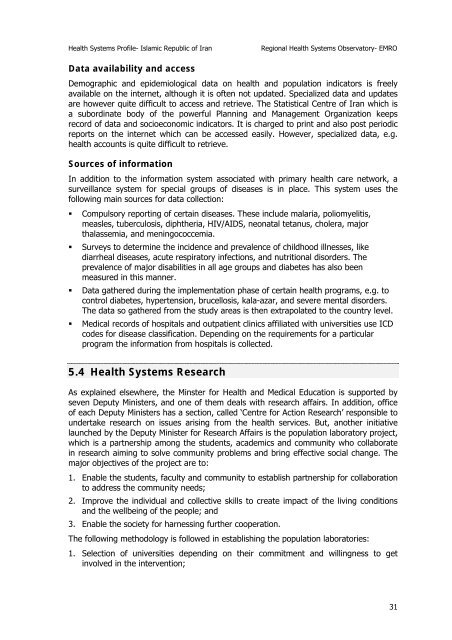Health system profile - Islamic Republic of Iran - What is GIS - World ...
Health system profile - Islamic Republic of Iran - What is GIS - World ...
Health system profile - Islamic Republic of Iran - What is GIS - World ...
Create successful ePaper yourself
Turn your PDF publications into a flip-book with our unique Google optimized e-Paper software.
<strong>Health</strong> Systems Pr<strong>of</strong>ile- <strong>Islamic</strong> <strong>Republic</strong> <strong>of</strong> <strong>Iran</strong> Regional <strong>Health</strong> Systems Observatory- EMRO<br />
Data availability and access<br />
Demographic and epidemiological data on health and population indicators <strong>is</strong> freely<br />
available on the internet, although it <strong>is</strong> <strong>of</strong>ten not updated. Specialized data and updates<br />
are however quite difficult to access and retrieve. The Stat<strong>is</strong>tical Centre <strong>of</strong> <strong>Iran</strong> which <strong>is</strong><br />
a subordinate body <strong>of</strong> the powerful Planning and Management Organization keeps<br />
record <strong>of</strong> data and socioeconomic indicators. It <strong>is</strong> charged to print and also post periodic<br />
reports on the internet which can be accessed easily. However, specialized data, e.g.<br />
health accounts <strong>is</strong> quite difficult to retrieve.<br />
Sources <strong>of</strong> information<br />
In addition to the information <strong>system</strong> associated with primary health care network, a<br />
surveillance <strong>system</strong> for special groups <strong>of</strong> d<strong>is</strong>eases <strong>is</strong> in place. Th<strong>is</strong> <strong>system</strong> uses the<br />
following main sources for data collection:<br />
Compulsory reporting <strong>of</strong> certain d<strong>is</strong>eases. These include malaria, poliomyelit<strong>is</strong>,<br />
measles, tuberculos<strong>is</strong>, diphtheria, HIV/AIDS, neonatal tetanus, cholera, major<br />
thalassemia, and meningococcemia.<br />
Surveys to determine the incidence and prevalence <strong>of</strong> childhood illnesses, like<br />
diarrheal d<strong>is</strong>eases, acute respiratory infections, and nutritional d<strong>is</strong>orders. The<br />
prevalence <strong>of</strong> major d<strong>is</strong>abilities in all age groups and diabetes has also been<br />
measured in th<strong>is</strong> manner.<br />
Data gathered during the implementation phase <strong>of</strong> certain health programs, e.g. to<br />
control diabetes, hypertension, brucellos<strong>is</strong>, kala-azar, and severe mental d<strong>is</strong>orders.<br />
The data so gathered from the study areas <strong>is</strong> then extrapolated to the country level.<br />
Medical records <strong>of</strong> hospitals and outpatient clinics affiliated with universities use ICD<br />
codes for d<strong>is</strong>ease classification. Depending on the requirements for a particular<br />
program the information from hospitals <strong>is</strong> collected.<br />
5.4 <strong>Health</strong> Systems Research<br />
As explained elsewhere, the Minster for <strong>Health</strong> and Medical Education <strong>is</strong> supported by<br />
seven Deputy Min<strong>is</strong>ters, and one <strong>of</strong> them deals with research affairs. In addition, <strong>of</strong>fice<br />
<strong>of</strong> each Deputy Min<strong>is</strong>ters has a section, called ‘Centre for Action Research’ responsible to<br />
undertake research on <strong>is</strong>sues ar<strong>is</strong>ing from the health services. But, another initiative<br />
launched by the Deputy Min<strong>is</strong>ter for Research Affairs <strong>is</strong> the population laboratory project,<br />
which <strong>is</strong> a partnership among the students, academics and community who collaborate<br />
in research aiming to solve community problems and bring effective social change. The<br />
major objectives <strong>of</strong> the project are to:<br />
1. Enable the students, faculty and community to establ<strong>is</strong>h partnership for collaboration<br />
to address the community needs;<br />
2. Improve the individual and collective skills to create impact <strong>of</strong> the living conditions<br />
and the wellbeing <strong>of</strong> the people; and<br />
3. Enable the society for harnessing further cooperation.<br />
The following methodology <strong>is</strong> followed in establ<strong>is</strong>hing the population laboratories:<br />
1. Selection <strong>of</strong> universities depending on their commitment and willingness to get<br />
involved in the intervention;<br />
31

















